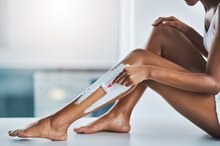Causes of an Inner Groin Rash
Moisture from perspiration, tight clothing, skin creases where chaffing can occur, and the normal proliferation of fungi and bacteria on the skin make the inner groin area a prime location for the development of skin rashes. Several types of rashes can develop in this area, with different characteristics and symptoms. Simple treatments and self-care measures often suffice to clear most types of inner groin rashes.
Intertrigo
Intertrigo develops when moist areas of skin rub against each other, causing inflammation and breakdown of the tissue. Intertrigo characteristically develops in skin folds, including the groin area.
The involved skin appears red and raw, is often tender, and may itch. The skin sometimes cracks and oozes. Crusting can occur if the rash persists. Breakdown of skin affected by intertrigo leaves the area vulnerable to secondary infection by bacteria or yeast.
Treatment for intertrigo involves keeping the area cool, clean and dry. Absorbent powders are often helpful. Secondary infection is usually treated with topical antifungal or antibacterial creams or pastes 3.
- Intertrigo develops when moist areas of skin rub against each other, causing inflammation and breakdown of the tissue.
- Breakdown of skin affected by intertrigo leaves the area vulnerable to secondary infection by bacteria or yeast.
Jock Itch
Causes of Severe Groin Itching
Learn More
Jock itch -- known medically as tinea cruris -- refers to a superficial skin infection in the groin area caused by fungi called dermatophytes.
The infection is limited to the uppermost layer of the skin, called the stratum corneum. A warm, moist environment promotes the growth of dermatophytes, which is why the groin is often affected. The rash appears as a reddish patch, usually with a raised leading edge that is frequently scaly. Jock itch is notoriously itchy, and the infection is contagious.
Jock itch can usually be effectively treated with a topical over-the-counter or prescription antifungal, such as terbinafine (Lamisil) or clotrimazole (Lotrimin AF, Mycelex). To avoid spreading the infection, it's important to avoid sharing towels or clothing that comes into contact with the affected area until the rash clears.
- Jock itch -- known medically as tinea cruris -- refers to a superficial skin infection in the groin area caused by fungi called dermatophytes.
- A warm, moist environment promotes the growth of dermatophytes, which is why the groin is often affected.
Erythrasma
Erythrasma is a superficial skin infection caused by a bacterium called Corynebacterium minutissimum. As with other groin rashes, a warm and moist environment favors the development of erythrasma. The involved area shows irregular but well-defined red patches. The affected skin typically appears slightly scaly and wrinkled. The area may be slightly itchy, but many people do not experience itchiness with this skin infection.
Erythrasma is usually with a topical or oral antibiotic, such as erythromycin (ERYC) or clarithromycin (Biaxin). Use of antibacterial soap may be recommended to prevent a recurrence.
- Erythrasma is a superficial skin infection caused by a bacterium called Corynebacterium minutissimum.
- The area may be slightly itchy, but many people do not experience itchiness with this skin infection.
Folliculitis and Pseudofolliculitis
Causes of Rash in the Genital Area
Learn More
Folliculitis is a skin condition caused by inflammation of the hair follicles. It occurs due to irritation, infection or both. Staphylococcus aureus (S. aureus) bacteria are most commonly involved. The rash appears as red bumps arising from the hair follicles with tiny pimple-like heads at the skin surface. The rash is sometimes tender, but itchiness usually isn't a prominent symptom. Folliculitis is common in the groin region, and tight clothing favors the development of this rash. Waxing or shaving of groin hair increases the risk of folliculitis. Pseudofolliculitis, or ingrown hairs, is another common cause of groin rash in people who wax, pluck or shave hairs in this region.
Irritant folliculitis in the groin typically resolves on its own by avoiding tight clothes. A topical antibiotic, such as clindamycin (Cleocin T), is often recommended since S. aureus infection is common with folliculitis.
Post-hair-removal creams and lotions might help with pseudofolliculitis. Avoidance of tight clothing can also be helpful.
- Folliculitis is a skin condition caused by inflammation of the hair follicles.
- Folliculitis is common in the groin region, and tight clothing favors the development of this rash.
Considerations
Groin rashes can be troublesome and embarrassing, but are very common. Many of these rashes appear similar, making it difficult to self-diagnose the cause. A visit to your doctor is usually the best option to ensure you have an accurate diagnosis and appropriate treatment plan 3. Prompt medical evaluation and treatment are especially important for people with diabetes or a condition that weakens the immune system, such as HIV/AIDS or current cancer treatment.
Reviewed by: Tina M. St. John, M.D.
- Groin rashes can be troublesome and embarrassing, but are very common.
- Prompt medical evaluation and treatment are especially important for people with diabetes or a condition that weakens the immune system, such as HIV/AIDS or current cancer treatment.
Related Articles
References
- Merck Manual Professional Version: Intertrigo
- Manual of Dermatologic Therapeutics, 8th Edition; Kenneth A. Arndt, et al.
- Diagnosis and Treatment of Fungal Infections, 2nd Edition; Duane R. Hospenthal and Michael G. Rinaldi
- Merck Manual Professional Version: Folliculitis
- Genital Dermatology Atlas, 2nd Edition; Libby Edwards and Peter J. Lynch
- Kalra MG, Higgins KE, Kinney BS. Intertrigo and secondary skin infections. Am Fam Physician. 2014;89(7):569-73.
- Ely JW, Rosenfeld S, Seabury stone M. Diagnosis and management of tinea infections. Am Fam Physician. 2014;90(10):702-10.
- Sahoo AK, Mahajan R. Management of tinea corporis, tinea cruris, and tinea pedis: A comprehensive review. Indian Dermatol Online J. 2016;7(2):77-86. doi:10.4103/2229-5178.178099
Writer Bio
Katherine Mariaca is a professional freelance journalist who specializes in alternative and complementary medicine, and skin and body care treatments. A longtime spa director and VP of skin care companies, Mariaca developed products and services for the spa industry. She earned a B.S. from Tufts and an M.F.A. from Lesley.





